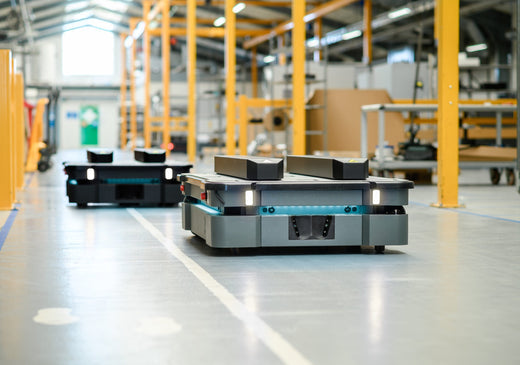
Trends Redefining the Autonomous Mobile Robot Market
Share

The field of autonomous mobile robots (AMRs) is experiencing a remarkable transformation as technological advancements drive versatility, reliability, and cost-effectiveness. These developments are expanding the deployment of AMRs across industries such as manufacturing, healthcare, agriculture, and logistics. Here are the trends redefining the AMR landscape, offering investors an exciting glimpse into the future.
Autonomous Mobile Robots: A Technological Transformation
AMRs are currently undergoing a transformation with rapid technological advancements. Integrating AI and ML has empowered AMRs to operate autonomously and make intelligent decisions based on sensor data. Furthermore, improved sensor technologies have greatly enhanced their perception and navigation capabilities. The emergence of swarm robotics has revolutionized AMRs, enabling seamless collaboration and communication among multiple robots and resulting in more efficient task execution. The integration of IoT has further elevated their functionality and connectivity.
Future AMRs will exhibit improved capabilities, with the ability to handle delicate objects and perform intricate tasks precisely. Advancements in mobility will enable robots to navigate challenging terrains, including uneven surfaces, stairs, and obstacles. This will expand their range of applications in industries such as construction and search and rescue.
Artificial Intelligence and Machine Learning
Artificial intelligence (AI) and machine learning (ML) have revolutionized AMRs, enabling them to operate autonomously and intelligently in dynamic environments. Through advanced algorithms, AMRs can perceive their surroundings, navigate complex terrains, and make informed decisions in real-time. ML also enables continuous learning, allowing robots to enhance their mapping, localization, and decision-making capabilities over time.
Case Study: In March 2023, Thira Robotics launched Yara, a new generation of modular AMRs for industrial environments. Yara robots feature advanced AI algorithms, making them adaptable and capable of interacting with other machines. These robots perform tasks such as material handling, logistics, quality control, and inspection—either independently or as part of a larger robot network—making them suitable for industries like manufacturing, healthcare, and hospitality.
Enhanced Sensor Technologies
Recent innovations in sensor technologies have significantly improved AMRs’ perception and navigation capabilities. Compact and precise sensors like LiDAR, cameras, depth sensors, and ultrasonic sensors allow robots to detect obstacles, map environments accurately, and navigate autonomously in complex and dynamic settings.
Example: In March 2023, OTTO Motors introduced the OTTO 600, equipped with advanced LiDAR and depth sensors. These technologies enable the OTTO 600 to perceive its environment in real time, detect obstacles, and adapt to changing conditions, ensuring safe and efficient operation in challenging environments.
Swarm Robotics
Swarm robotics is a transformative trend that leverages the collective behavior of multiple robots working together to accomplish tasks. This approach draws inspiration from social insects, enabling AMRs to communicate, share information, and coordinate actions effectively.
Applications:
· In agriculture, swarms can monitor crops and optimize resource allocation.
· In logistics, AMRs collaborate to streamline goods transportation.
· In search and rescue, swarm robotics allows for efficient exploration of hazardous areas, increasing the chances of success.
By harnessing collective intelligence, swarm robotics enhances the capabilities and efficiency of AMRs across various industries, unlocking new possibilities for collaboration and adaptability.
The Integration of the Internet of Things (IoT)
The convergence of IoT and AMRs is revolutionizing robotic systems by enhancing connectivity, functionality, and overall performance. IoT-enabled sensors allow AMRs to gather real-time data—such as temperature, humidity, and object presence—and adapt operations accordingly.
Key Developments:
· IoT Connectivity: AMRs communicate with central control systems, cloud platforms, or other robots via wireless protocols, enabling coordination and efficient task allocation. For example, a fleet of AMRs in a warehouse can optimize inventory management through synchronized operations.
· Remote Monitoring: Operators can track AMR performance and status in real time, enabling proactive maintenance and operational adjustments to minimize downtime.
· Advanced Analytics: Data collected by IoT-enabled AMRs can be processed through cloud computing and analytics to optimize routes, predict maintenance needs, and refine strategies for increased efficiency.
Conclusion
The autonomous mobile robot landscape is rapidly evolving, driven by advancements in AI, sensor technologies, swarm robotics, and IoT integration. These innovations enhance the versatility, efficiency, and reliability of AMRs, positioning them as indispensable assets across industries. For investors, this dynamic market presents an unparalleled opportunity to capitalize on the transformative potential of robotics and automation.
As businesses increasingly adopt AMRs, the future of this industry promises sustained growth, innovation, and a significant impact on global operations. Now is the time to invest in the technologies shaping the next frontier of autonomous mobility.